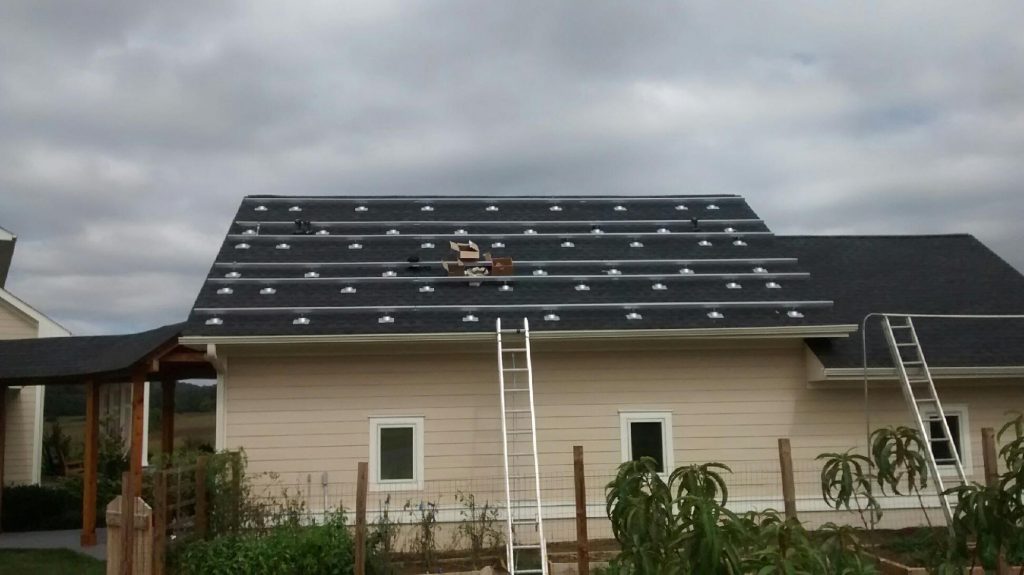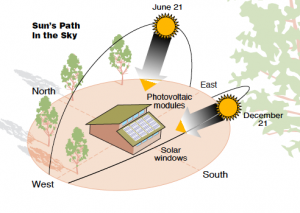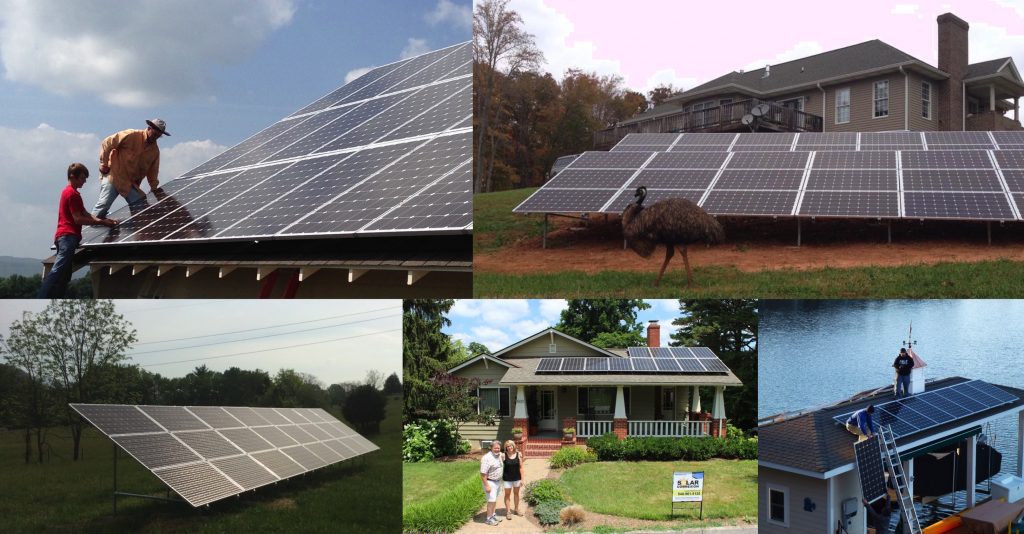Join the growing community of residential solar energy producers with a photovoltaic system from Solar Connexion. With our experience and installation techniques, our customers can be confident that their investment and energy production will be maximized. The listed systems are grid-tied, net metered systems which are the most economical and “greenest” way to go! (Contact us for information on grid-interactive and off-grid battery-based systems).
Find out about the solar potential of your home by completing our short online form here.
 9-panel, roof-mount, 2.61 kW array
9-panel, roof-mount, 2.61 kW array
$8775* ($6142 with offset from the 30% Federal Tax Credit)
can generate around 3101 kWh per year for a south-facing, shade-free location in SWVA**
12-panel, roof-mount, 3.48 kW array
$10,950* ($7665 with offset from the 30% Federal Tax Credit)
can generate around 4180 kWh per year for a south-facing, shade-free location in SWVA**
12-panel, ground-mount, 3.48 kW array
$12,800* *** ($8960 with offset from the 30% Federal Tax Credit)
can generate around 4350 kWh per year for a south-facing, shade-free location in SWVA**
24-panel, ground-mount, 6.96 kW array
$23,250* *** ($16275 with offset from the 30% Federal Tax Credit)
can generate around 8700 kWh per year for a south-facing, shade-free location in SWVA**
* some additional electrical work may be required,
** based on PVWatts and historical weather data for the New River Valley, similar for most of SWVA
*** additional wiring/conduit costs for arrays more than 150′ from the electric meter
Should I go with roof mount or ground mount?
It will likely depend on your site but in some cases both may be options. Ground-mount arrays are more productive than roof-mount because they have better airflow, cooler panels operate more efficiently, and we can orient the array optimally. Roof-mount is more economical as it doesn’t require the structural steel, concrete, trenching, and additional wire and conduit of ground-mount.
Will it offset all my electric use?
It depends on your particular electric use but probably not. Divide the yearly estimated generation given above by your yearly electric use in kWh to see what percentage you could offset.
If I can’t make all my own energy, what’s the use?
No matter the size, it’s still a sound financial and environmental investment. We find that by producing some of their own energy, our customers naturally find ways to reduce the gap between production and consumption. After the system has paid for itself (in ~ 10-12 years for roof-mount, ~12-15 for ground mount) that part of your electricity is essentially free! Space permitting, you can also add another array in the future. Making your own electricity is rewarding and offers many positive benefits. A photovoltaic system will add value to your home! (Find out how much energy you could produce by requesting a site evaluation here.)
What equipment do you use?
We use the highest-quality, time-proven equipment including SMA inverters or Enphase microinverters, 290w SolarWorld SunModules, ProSolar rail and fully booted stand-offs or standing seam clamps (roof mounts), and ProSolar GroundTrac (ground-mount). The inverters are sized to process the full potential of the array; they are never undersized. We don’t skimp on wiring and our craftsmanship and know-how minimize system losses.
What will this system power? Will I get paid for the electricity I produce?
The energy you produce is fed into your electric panel and if it can be used on-site, it is. Just like you don’t have to direct where power goes from the power company, you don’t with a grid tie system either; it’s used where needed. When there is a surplus of electricity generated by the array, it’s sent back to the electric utility through a bi-directional meter and you receive credit for it through a Net Metering agreement. Your electric bill will be the difference between what you consumed from the electric utility and what you sent to them. You aren’t paid for the electricity but you do receive a 1-to-1 credit.
You can earn Solar Renewable Energy Credits (SRECs) from your solar energy production and be paid for each mWh of electricity you produce – around 3 SRECs for the 9-panel =, 4 SRECS for 12-panels, and 8 or 9 for the 24-panel system. Learn more about that here.
What is included in the system price?
The system price (plus any site-dependent additional fees and optional add-ons) is for a turn-key system, including permitting, interconnection application, and all material and labor with the exception of: any patching & painting (we seal all wall & floor penetrations and rough replace any removed drywall); finish ground/landscape work if trenching is required (we scatter straw & seed over a mound-filled ditch); and tree clearing.
What warranties are included?
- Panels: 10 year product, 25 year power output
- Inverters: 10 years (optional add-on up to 20)
- Racking: 10 years
- Workmanship: 10 years
- Any item without a specified warranty: 5 years
Are other system sizes available?
Yes. We can price any other system size. We can design to fit a budget or a particular energy production goal!
Will this provide me with electricity during a power outage?
No. The electricity from the solar array is synchronous with the power from the electric company. When the grid is down, the system automatically shuts down during a power outage for safety. However, the SMA TL line of inverters offers a secure power supply feature that can provide up to 1500w while the sun is shining. (We also design and install battery backup systems, but note that grid-tie battery-less systems are by far the most economical option. Contact us at info@solarconnexion.com for a battery backup design.)
How long does the installation process take?
Just a day or two, or a few depending on size or complexity, but adding in time for permitting, weather, local inspection, and electric utility inspection/net metering connection it can take up to 8 weeks.
Is my house suitable for solar?
We will determine that. For roof mount, we look for south-facing roof surfaces (but we can go east/west, just not north) with little to no shading from trees, buildings, or other obstructions to the east, west, and south. We’ll also need to be sure that the roof is in good condition, not nearing the end of its projected lifespan, and if it’s an older structure, it may need an engineering analysis.
For ground-mount, we want an open area that is free from shading for the vast majority of the day. A good rule of thumb is that we want the array to be away from shade-producing trees and objects by a distance of about 2.7 times the height of the tree/object.
How do we find out more?
If you are interested, please complete this online information form and we will first take a look at your homesite on GIS and then contact you to arrange a meeting and site visit.
Why work with Solar Connexion?
We have 24 years of experience in solar contracting and maintain the highest standards for our systems and customer service (and a Top-500 solar contractor for the second year in a row). From small residential systems to large-scale complex off-grid systems, our systems consistently outperform those of other contractors. We do our part to encourage solar in the community through free workshops and support of public projects.
Are you ready?
Take the first step by completing our short online information form here!





